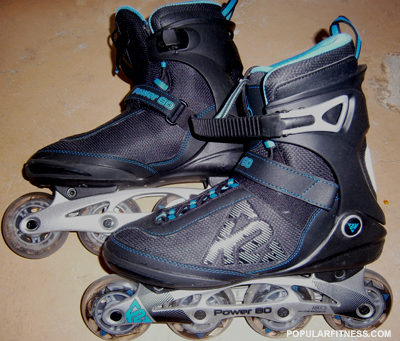
Inline skating (rollerblading) is an enjoyable and fun way to get in shape and stay fit especially on warm sunny days when it's a lot more enjoyable to exercise outdoors than on a treadmill or exercise bike indoors at the gym. These days many cities have nicely paved paths through parkland, beach and waterfront areas to make your rollerblading experience more enjoyable and safe. Unfortunately depending on where you live, you may not be able to or want to rollerblade all year round.
There are many benefits to be derived from inline skating. It's much easier and safer on the knees and back than jogging since your legs aren't taking as much of a pounding against a hard surface. You don't have to travel as far as with cycling to get maximum exercise benefits. You will achieve a more effective workout in less time. Along with a great cardiovascular workout, blading provides you with a fantastic lower body and core workout by strengthening and toning your thighs, glutes (butt), calves, hamstrings, abs and lower back. It's like doing thousands of lunges using your own body weight without even realizing it or getting bored!
Strength training for inline skating
I also recommend that you combine rollerblading with strength training exercises with weights such as leg extensions, leg presses, glutes and complete leg exercises, calf raises and deadlifts, just to name a few... This will ensure that your leg muscles and bones remain strong and it helps to prevent any possible injuries from occurring while blading or encountering environmental obstacles.
Before you begin inline skating for the day, you may want to do a little bit of light stretching particularly focusing on your thighs and hamstrings. There is always debate over whether or not to stretch before exercising. I believe you should do what feels best for you. Also, the first few minutes should be done at a slower pace as a warm up for your leg muscles.
I find that roller blading is extremely safe once you get proficient at it. Rarely will you fall by yourself. If you do, it's usually a result of your surroundings. No different than cycling or walking on a sidewalk. To prevent injuries and scrapes, you may wish to purchase elbow, wrist and knee pads plus a helmet.
What should you look for when buying a pair of inline skates?
If you're new to this sport, I suggest you either borrow a pair from a friend or rent a pair just to try it out, get a feel for the activity. When you're ready to buy a pair there are a few things to look for. If you're going to buy a really cheap pair I'll guarantee you that you will not enjoy inline skating. What I suggest that you buy a decent to good pair in the mid-price range.
The obvious being that the boot fits your feet properly in a pair of sports socks. If you feel the boot rubbing against your ankles or your toes rubbing inside the boot, try another pair because ill-fitted boots will result in blisters and soar feet resulting in a painful experience, no different than a badly fitting pair of running shoes.
I prefer laces for the boot with one plastic or velcro strap at the top and soft boots with plastic heel and bottom moldings for extra support. Soft boots with no plastic molding support usually give way to your ankle over time. Wheels should be in the 76-82mm range. Higher than 82mm is too big a wheel for most people and those blades are built for speed. Look for bearings with at least ABEC 5. Most quality inline skates come with ABEC 5 bearings nowadays anyway. Also note that rollerblades with the hockey boot are not ideal for long distance blading, but more suitable for road hockey, etc...
I've tried several different brands of inline skates over the years. I find that I like K2 the best and highly recommend them, especially on sale in the price range of around $149 - $199. I like their sleek design, they fit my feet very well and provide excellent support. K2s are also very comfortable and light in weight.
Maintenance
Inline skates are easy to maintain. The wheels need to be rotated every once in awhile to prevent uneven wearing out. So if you use them 3 times a week, rotating the wheels monthly or every 6 weeks is fine or take a look for how much wear there is on the wheels. The bearings need to be lubricated too. I do this by removing the wheel bearings assembly or casing from the wheel and then wiping the surface of any dirt and then spraying the entire wheel bearing casing with lubricant. I don't remove the bearings from the assembly casing anymore since I find very little dirt gets in there and it's a lot of time-consuming work. If you find that even this process is too much work, just remove the wheels and wipe down the bearing casings and then add new lubricant and rotate the wheels.
What time of lubricant should you buy? You can opt to buy inline skate lubricant at any sports store but it is very, very expensive and not necessary. I use 3-IN-ONE multi-purpose oil or any similar type of brand which is very inexpensive in price and works very well and you can pck it up at any Walmart or hardware store.
I also suggest that if you happen to be rollerblading while raining or on wet pavement that you add oil to the bearing casings afterwards, the next day or once dry, to keep them running smoothly and to prevent the bearings from rusting and getting damaged. This can be done simply by injecting a few drops of oil on every wheel casing and then spinning the wheel to spread the oil out over the entire casing and bearings.
Tips
Never throw away the wheels (if they are not broken or worn out) and parts of old rollerblades like the screws and stems because you may find that you can still use them or need them in the future. For example, the wheels of today's manufactured rollerblades tend to wear out and break faster compared to those manufactured from the mid 2000s. In fact, all the wheels wore out or broke on my currently used rollerblades so I replaced them with the K2 wheels from my 2002 rollerblades. Been using them for 2.5 years now. They are harder and of more durable quality.
Conclusion
In this article, I have discussed the cardiovascular and strength training benefits associated with inline skating. What you should look for when purchasing a pair of inline skates and their proper maintenance.
